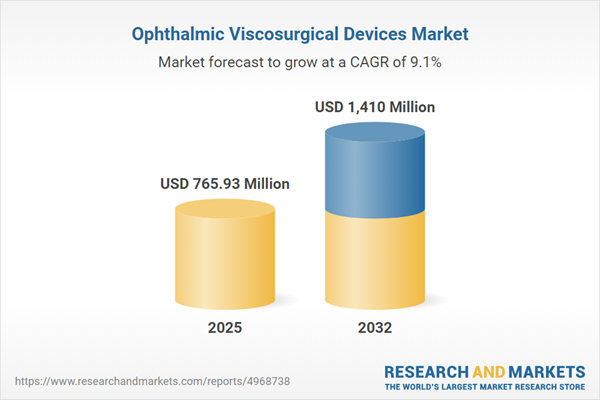Speak directly to the analyst to clarify any post sales queries you may have.
The ophthalmic viscosurgical devices market is evolving rapidly, as demand grows for advanced solutions that enhance safety and precision in a variety of surgical settings. Senior decision-makers seeking clarity on market opportunities, competitive landscapes, and operational risks will benefit from comprehensive insights that support confident, well-informed strategies.
Ophthalmic Viscosurgical Devices Market Snapshot
The Ophthalmic Viscosurgical Devices Market grew from USD 702.86 million in 2024 to USD 765.93 million in 2025. It is expected to continue growing at a CAGR of 9.12%, reaching USD 1.41 billion by 2032. The market is driven by ongoing innovation in viscoelastic formulations and integration with modern surgical platforms, reflecting a need for solutions that optimize both clinical outcomes and operational efficiencies. Growth is supported by international collaboration, evolving device standards, and a focus on regional adoption trends across established and emerging healthcare systems.
Scope & Segmentation
This report offers an extensive and detailed view of the ophthalmic viscosurgical devices market, including segmentation across product types, composition, end users, applications, distribution, and regional dynamics. Key segmentation elements include:
- Product Types: Cohesive, Combined, Dispersive, Viscoadaptive
- Composition: Combination, Hydroxypropyl Methylcellulose, Sodium Hyaluronate
- Applications: Cataract Surgery, Corneal Surgery, Glaucoma Surgery, Vitreoretinal Surgery
- End Users: Ambulatory Surgery Centers, Hospitals, Specialty Clinics
- Distribution Channels: Direct Sales, Distributor Partners, Ecommerce
- Regions Covered: Americas (North America: United States, Canada, Mexico; Latin America: Brazil, Argentina, Chile, Colombia, Peru), Europe, Middle East & Africa (Western and Eastern European countries, select Middle Eastern and African markets), Asia-Pacific (China, India, Japan, Australia, South Korea, Indonesia, Thailand, Malaysia, Singapore, Taiwan)
- Key Industry Players: Alcon Laboratories, Johnson & Johnson, Bausch + Lomb, Carl Zeiss Meditec, HOYA Surgical Optics, Santen Pharmaceutical, Rayner Group, Nordic Pharma, Bohus BioTech, BVI Medical
Key Takeaways for Senior Decision-Makers
- Advances in viscoelastic materials are enabling tailored performance for procedures such as high-speed phacoemulsification and membrane peeling, supporting improved surgeon control and patient outcomes.
- The market’s competitive landscape is actively shaped by strategic collaborations, with device manufacturers and laser system providers streamlining workflows and research to address evolving clinical requirements.
- Heightened regulatory scrutiny is leading companies to enhance biocompatibility testing, product consistency, and post-market vigilance, creating both compliance challenges and opportunities to strengthen product credibility.
- Distribution strategies incorporating direct, partner, and ecommerce channels are expanding market reach, enabling broader access especially in regions with diverse procurement practices and regulatory standards.
- Resilient supply chains and localized manufacturing capabilities are increasingly important as manufacturers respond dynamically to external pressures and cost fluctuations.
Tariff Impact and Supply Chain Adaptation
Recent revisions to tariff schedules in the United States are influencing supply chain strategies, particularly for core raw materials used in viscoelastic agent production. Companies are reevaluating supplier portfolios, sourcing alternatives in tariff-exempt areas, and accelerating domestic manufacturing to offset rising input costs. Healthcare providers are managing these changes by adopting long-term contracts, leveraging purchasing group alliances, and exploring inventory optimization to maintain access and affordability for key ophthalmic viscosurgical solutions.
Methodology & Data Sources
This report uses a robust, triangulated research approach combining primary interviews with surgeons, procurement managers, and clinical specialists, alongside secondary analysis of peer-reviewed publications, regulatory dossiers, and patent data. Technical validation was performed by consulting with polymer chemists and biomedical engineers, strengthening the accuracy of findings and recommendations. Quality assurance was maintained at every analytical stage for maximum data reliability.
Why This Report Matters
- Empowers business leaders with actionable insights to drive competitiveness and operational excellence in a complex, regulated environment.
- Enables strategic investment based on comprehensive segmentation, emerging technology integration, and proven regional growth models.
- Equips stakeholders to navigate regulatory shifts and supply chain disruptions with resilience, supporting uninterrupted access to advanced ophthalmic viscosurgical devices.
Conclusion
This report offers senior stakeholders a precise, actionable view of the ophthalmic viscosurgical devices market. Informed strategies, built on robust analysis and forward-looking perspectives, will secure advantage in a rapidly advancing surgical landscape.
Additional Product Information:
- Purchase of this report includes 1 year online access with quarterly updates.
- This report can be updated on request. Please contact our Customer Experience team using the Ask a Question widget on our website.
Table of Contents
3. Executive Summary
4. Market Overview
7. Cumulative Impact of Artificial Intelligence 2025
Companies Mentioned
The companies profiled in this Ophthalmic Viscosurgical Devices market report include:- Alcon Laboratories, Inc.
- Johnson & Johnson
- Bausch + Lomb Incorporated
- Carl Zeiss Meditec AG
- HOYA Surgical Optics, Inc.
- Santen Pharmaceutical Co., Ltd.
- Rayner Group
- Nordic Pharma, Inc.
- Bohus BioTech AB
- BVI Medical, Inc. a
Table Information
| Report Attribute | Details |
|---|---|
| No. of Pages | 184 |
| Published | November 2025 |
| Forecast Period | 2025 - 2032 |
| Estimated Market Value ( USD | $ 765.93 Million |
| Forecasted Market Value ( USD | $ 1410 Million |
| Compound Annual Growth Rate | 9.1% |
| Regions Covered | Global |
| No. of Companies Mentioned | 11 |









